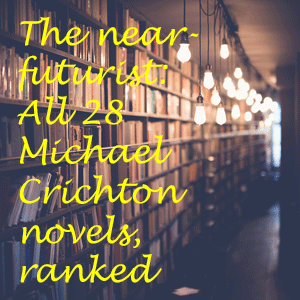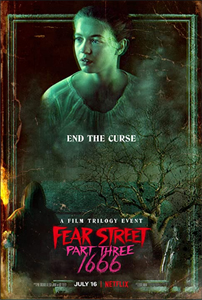“Fear Street Part Three: 1666” goes back to Colonial New England to wrap up Netflix’s three-week trilogy. If “Part One: 1994” was like “Scream” and “Part Two: 1978” was like “Friday the 13th,” the capper is like … “The VVitch” maybe?
Pilgrimage in time
That comparison doesn’t do “Fear Street” any favors. It’s not like it wallows in mood or tries to capture the era’s speaking style (everyone uses accents, though). Still, this is a rock-solid young-adult version of horror in the time of the Pilgrims.
The big problem with these films (all directed by Leigh Janiak) is that we’ve seen it done better elsewhere. But if a teen viewer is tip-toeing into horror, they might love this trilogy.
“Fear Street Part Three: 1666” (2021)
Director: Leigh Janiak
Writers: Phil Graziadei, Leigh Janiak, Kate Trefry (screenplay); R.L. Stine (“Fear Street” books)
Stars: Kiana Madeira, Ashley Zukerman, Gillian Jacobs
The characters and actors have grown on me. The first film focused on the lightly forbidden love story of Deena (Kiana Madeira) and Sam (Olivia Scott Welch). This one focuses on the extremely forbidden love story of Sarah Fier (Madeira) and Hannah (Welch).
True, gay people were oppressed in the 1990s. But in 1666, it was literally a matter of life or death, as both are soon in danger of being hanged as witches.
Witchy women?
Interestingly, although we know the teen girls are innocent, there unquestionably is witchcraft going on in Union (which will later become Sunnyvale/Shadyside). The crops are blighted and water poisoned, but only to the edge of town.
For the first time, the series engages in mystery as we ask “Who is truly responsible for the witchcraft?” It’s solved too quickly for a viewer to give much thought to it. And I still wonder if the overall story would’ve been more engaging with a foregrounded mystery.
After Deena magically sees Sarah’s tragic story, the last 45 minutes bring us back to 1994. And it’s mostly welcome.
A strong finish
In addition to the obvious gay oppression theme, writers Phil Graziadei, Janiak and Kate Trefry more daringly hint (unless it’s an accident) at an anti-government statement.
I had read the Sunnyvale/Shadyside dichotomy as a cute YA version of two sides of the tracks, so “1666” surprises me by revealing the reason for it. Local government has kept Shadyside in its crime-ridden and impoverished state.
The trilogy is mostly surface entertainment that resists scratching deeper, but it’s not dumb. Horror-viewing veterans who stay through “Part Three: 1666” won’t be blown away, but at least they’ll find “Fear Street” flows in a positive direction.


